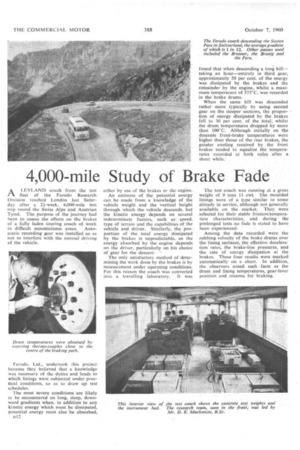4,000-mile Study of Brake Fade
Page 60

If you've noticed an error in this article please click here to report it so we can fix it.
ALEYLAND coach from the test fleet of the Ferodo Research Division reached London last Saturday after a 21-week, 4,000-mile test trip round the Swiss Alps and Austrian Tyrol. The purpose of the journey had been to assess the effects on the brakes of a fully laden touring coach of work in difficult mountainous areas. Automatic recording gear was installed so as not to interfere with the normal driving of the vehicle.
Ferodo, Ltd., undertook this project because they believed that a knowledge was necessary of the duties and loads to which linings were subjected under practical conditions, so as to draw up test schedules.
The most severe conditions are likely to be encountered on long, steep, downward gradients when, in addition to any kinetic energy which must be dissipated, potential energy must also be absorbed, 1312 either by use of the brakes or the engine.
An estimate of the potential energy can be made from a knowledge of the vehicle weight and the vertical height through which the vehicle descends, but the kinetic energy depends on several indeterminate factors, such as speed, type of terrain and the capabilities of the vehicle and driver. Similarly, the proportion of the total energy dissipated by the brakes is unpredictable, as the energy absorbed by the engine depends on the driver, particularly on his choice of gear for the descent.
The only satisfactory method of determining the work done by the brakes is by measurement under operating conditions. For this reason the coach was converted into a travelling laboratory. It was found that when descending a long hill---taking an hour—entirely in third gear, approximately 50 per cent. of the energy was dissipated by the brakes and the remainder by the engine, whilst a maximum temperature of 375°C, was recorded in the brake drums.
When the same bill was descended rather more typically by using second gear on the steeper sections, the proportion of energy dissipated by the brakes fell to 30 per cent, of the total, whilst the drum temperatures dropped by' more than 100°C. Although initially on the descents front-brake temperatures were higher than those of the rear brakes, the greater cooling received by the front brakes tended to equalize the temperatures recorded at both axles after a short while.
The test coach was running at a gross weight of 9 tons 11 cwt. The moulded linings were of a type. similar to some already in service, although not generally available on the market. They were selected for their stable friction/temperature characteristics, and during • the prolonged tests no fade is stated to have been •experienced.
Among the data recorded were the rubbing velocity of the brake drums over the lining surfaces, the effective deceleration rates, the brake-line pressures, and the rate of energy dissipation at the brakes. These four results were marked automatically on a chart. In addition, the observers noted such -facts as the drum and lining temperatures, gear-lever Position and reasons for 'braking.
































































































































